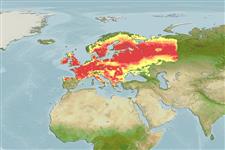Classification / Names
Common names from other countries
Main reference
Size / Weight / Age
Max length : 40.0 cm TL male/unsexed; (Ref. 30578); common length : 15.0 cm TL male/unsexed; (Ref. 556); max. published weight: 1.0 kg (Ref. 30578); max. reported age: 16 years (Ref. 41616)
Length at first maturity
Lm 17.9 range ? - ? cm
Environment
Freshwater; brackish; benthopelagic; pH range: 6.0 - 8.0; potamodromous (Ref. 51243); depth range 1 - ? m
Climate / Range
Temperate; 4°C - 22°C (Ref. 41616), preferred ?; 72°N - 41°N, 10°W - 155°E
Distribution
Europe and Asia: North, Baltic, White and Barents Sea basins; Caspian basin, in Volga and Ural drainages; Black Sea basin, from Danube to Dniepr drainages; Atlantic basin, in Seine drainage; Mediterranean basin from Rhône to Arch drainages (France). Only very localized in Danube main river in Romania, in Scandinavia north of 69°N and most of cenral Finland. Populations from Siberia and East Asia usually referred to Leuciscus leuciscus are distinct species, Leuciscus baicalensis and Leuciscus dzungaricus (Ref. 59043). Has become widespread in Europe and gained access to Ireland as a bait fish. At least one country reports adverse ecological impact after introduction (Ref. 1739).
Countries | FAO areas | Ecosystems | Occurrences | Introductions
Short description
Dorsal
spines
(total): 2 - 3;
Dorsal
soft rays
(total): 7-9;
Anal
spines: 3;
Anal
soft rays: 8 - 9;
Vertebrae: 42 - 46. Diagnosed from congeners in Europe by the following characters: subinferior or subterminal mouth; subequal jaw, upper jaw slightly longer; upper lip tip about level with center of eye; not projecting snout; articulation of lower jaw distinctly behind anterior margin of eye; horizontal branch of preoperculum shorter than vertical branch; and 40-50 + 1-2 scales on lateral line (Ref. 59043). Rarely longer than 30 cm TL; normally 47-52 scales in lateral line; anal fin concave; caudal fin forked with 19 rays (Ref. 41616).
IUCN Red List Status (Ref. 115185)
Threat to humans
Potential pest (Ref. 13686)
Human uses
Fisheries: of no interest; gamefish: yes; bait: usually
More information
ReferencesAquacultureAquaculture profileStrainsGeneticsAllele frequenciesHeritabilityDiseasesProcessingMass conversion
Tools
Special reports
Download XML
Internet sources
Estimates of some properties based on models
Phylogenetic diversity index
PD50 = 0.5000 many relatives (e.g. carps) 0.5 - 2.0 few relatives (e.g. lungfishes)
Trophic Level
2.9 ±0.1 se; Based on diet studies.
Resilience
Medium, minimum population doubling time 1.4 - 4.4 years (K=0.18-0.25; tm=3-4; tmax=10)
Vulnerability
Moderate to high vulnerability (48 of 100)
Price category
